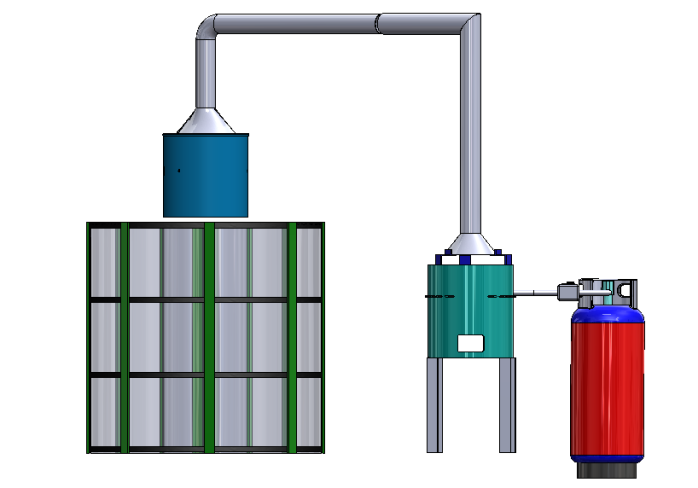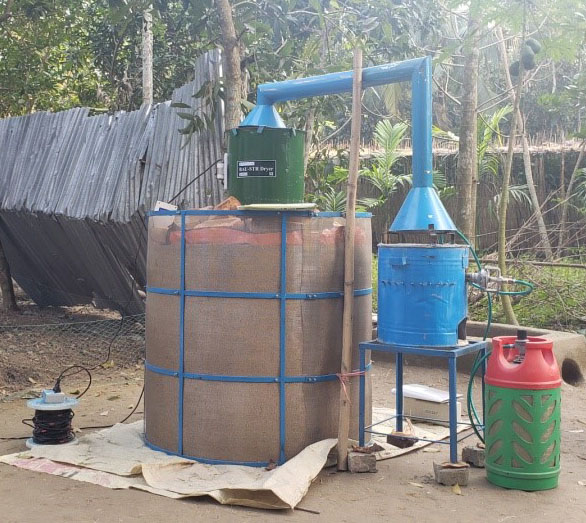BAU-STR Dryer: An Efficient Technological Solution for Reducing Post- Harvest Loss
By Chayan Kumer Saha and Md. Monjurul Alam
Department of Farm Power and Machinery, Bangladesh Agricultural University, Mymensingh-2202, Bangladesh
Email: cksaha(at)bau.edu.bd; mmalam.bau(at)gmail.com
Drying of paddy is an essential post-harvest operation before storing and processing of paddy. Poor or defective drying facilities or incorrect drying procedures may result in very fast drying rates, incomplete drying, moisture re-absorption and uneven moisture distribution within the grain mass. Improper drying results in high costs/storage loss, low efficiencies, high milling losses and poor quality of milled rice. Deterioration of paddy is accelerated when it is stored with high grain moisture content or is exposed to wet or high relative humidity conditions. Unless the grain is dried immediately and stored properly after harvest, losses are likely to be incurred at the pre-milling and milling stages. A grain dryer is a solution for the problems and can be evaluated properly only after reliable tests have been performed.
Sun drying is the traditional drying practice in Bangladesh. In sun drying, farmers leave their harvested paddy on the field, yard or concrete floor for a long time and the paddy is dried with the help of sun’s heat. It is a time-consuming process and it also depends on the weather conditions. Sudden changes in weather such as rain and foggy weather hamper the sun-drying process. These result in delayed drying, re-wetted grains and quality deterioration which cause damage in grain and reduce the quality and market value of grain. Therefore, alternate drying practices such as mechanical drying need to be adapted in Bangladesh to improve the drying performance.
An economical hot air circulated dryer was developed at Bangladesh Agricultural University, sponsored by USAID and the ADM Institute for the Prevention of Postharvest Loss sponsored the project entitled “Post-Harvest Loss Reduction Innovation Lab-Bangladesh” for rapid and efficient drying. This dryer is called BAU-STR dryer. The original STR dryer was a Vietnamese low-cost dryer developed by Centre for Agricultural Energy and Machinery, Long Nam University, Vietnam and Japan International Research Centre for Agricultural Sciences (JIRCAS). The same working principle of STR was used for developing the BAU-STR dryer using locally available materials in a sustainable manner for farmers and small traders.
The BAU-STR dryer consists of two cylinders (inner bin, outer bin), blower, hot air pipe, burner, bamboo, polythin sheets and rope. Outer and inner bins are stainless steel (SS) wire mesh (8 mesh). These cylinders are designed in such a way so that paddy or small grains can be properly placed into the annular space of the cylinders. Inner bin is fixed but outer bin can be adjusted for drying 300 to 500 kg per batch depending on the availability of grain for drying. The optimal setting of outer bin is for holding 500 kg of paddy. Rice husk briquettes are used as fuel. An axial Vietnamese blower was used initially to suck the hot air. Later, a blower has been developed by Post-Harvest Loss Innovation Lab (PHLIL)-Bangladesh using locally available material. The modified blower’s performance is similar to the Vietnamese blower. The function of the blower is to suck the hot air and push the hot air into the perforated cylinders evenly. The blower is powered by a 1 hp electrical motor. A hot air pipe is used for conveying the hot air which is generated by a burner. A temperature monitor meter has been added to continuously monitor temperature reading of grain, as high temperature or rapid drying reduces germination rate of seeds and milling yields, since cracks will develop.

LPG heating system-based BAU-STR Dryer schematic

A photo of the LPG heating system-based BAU-STR Dryer in use.
Several studies were done on BAU-STR dryer considering different seasons, different drying capacity, different verities, etc. BAU-STR dryer can dry the paddy within a very short period of time, i.e. in 3 to 5 hours depending on the initial moisture content. The moisture removal rate for each treatment was almost similar, around 2% mc per hr. The satisfactory germination rate and milling quality was found in BAU-STR dried paddy. In the primary stage, rice husk briquette was used as heat source. But, briquette burning capacity depends on moisture content and briquette quality. During the drying process, briquettes need to be fed frequently (every 5 minutes) in the dryer. However, briquettes are not available all over the country. Therefore, liquefied petroleum gas (LPG), a clean source for cooking and available all over Bangladesh, was considered as a heat source unit. An LPG-based heating system was developed for BAU-STR dryer using locally available materials, and drying efficiency was found better than the rice husk briquette-based heating system. LPG does not need to be refilled repeatedly during drying. Recently, LPG with a locally developed blower is found to be a better alternative than rice husk briquette as a heating source in BAU-STR dryer considering drying efficiency, germination percentage (above 90%) and milling recovery (around 75%). The operating cost and payback period of LPG-based BAU-STR dryer are 0.89 BDT per kg and less than one year, respectively. The post-harvest drying loss can be saved 2.5 to 4% in comparison to traditional sun drying method. The BAU-STR dryer using LPG as a clean heating source with locally manufactured blower would be the best option for the farmers, seed producers and small traders in Bangladesh as well as other rice-producing developing nations in the world.
